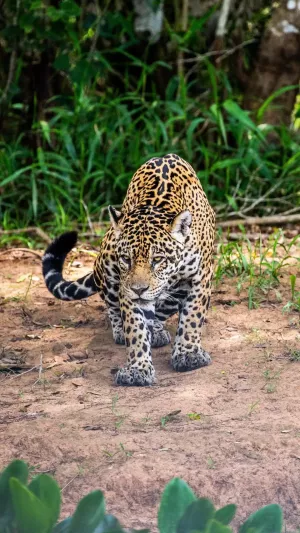The jaguar is the second largest cat in the world. Their coats vary in color, ranging from buff and ginger to reddish-brown, golden-yellow and brown. Their belly is white or cream. There are also large blocky spots or hollow round spots on the body, often with small black spots within the round spots. Not only that, but they also have melanistic individuals, which are more common in hot and humid lowland tropical forests.
Jaguars vary greatly in size. The jaguars living in Central America are the smallest, and the jaguars in the humid forest savanna of Brazil and Venezuela are the largest. The former is only half the size of the latter. The American body length is generally between 116 and 270 cm, and the weight can reach more than 150 kg.
The jaguar is distributed from northern Mexico to southern Argentina, and can be said to be widely distributed in most of northern and central South America.
In Mexico, Central America, eastern Brazil, and southern Bolivia, the distribution is mostly patchy, and there is no population in the United States, but jaguars often enter the United States to prey on Arizona. Jaguars can live in a variety of habitats, making good use of arid open savannas or deserts.
However, they prefer to live in dense lowland forests in the tropics and subtropics. They also like to be in areas with water, swamps, groves and mangrove areas along rivers, etc., and they are good swimmers and can cross large rivers.
The food of jaguars is very complex, and there are dozens of species recorded so far. Like all big cats, they mainly prey on local large prey. In their distribution area, large rodents such as capybara are the most important food for jaguars.
Of course, reptiles are also their favorite, such as the important caiman, other species are freshwater turtles, egg-laying turtles and large pythons. They can rely on abundant small prey, such as guinea pigs, short-horned deer and long-nosed raccoons, other diets also include otters, agouti.
At the same time, they can also prey on large prey such as the tapir and South American deer, the largest animal in South America.
Jaguars are basically harmless, and most of the records of attacking people are the result of extreme human provocation and preparation to hunt them. Among all cats, the jaguar has the strongest bite force in terms of body size. They kill their prey in two ways, one is to crush the animal's skull, and the other is to bite the throat and suffocate the prey to death. They mainly forage at night and in the morning and dusk, but jaguars are excellent at catching caiman and capybara in the water, and they also pick up carcasses.
Jaguars are definitely the overlords of Central America. They live alone and build a certain area. It's just that the area is relatively small, because the waters they live in and the distribution of their prey show significant seasonal changes. Territorial behaviors exhibited by jaguars include typical growling, marking with urine. Violent conflicts over territory are rare among adult jaguars, but there are records of deaths due to fighting.
Jaguars can breed year-round, and their cubs can be weaned at four or five months and can live independently in two years. As adults, males generally leave the birth area, while females stay near the birthplace, following the feline dispersal pattern. The mortality rate of jaguars is quite high, and the animals are considered to be a mortal threat to human life, so they are hunted by a large number of herders in Central America. Jaguars have no natural enemies in Central America, and if there is one, humans are the only one.
The jaguar's range is now halved, and has almost disappeared in the United States and Uruguay. Nonetheless, their habitat is there, as there are many inaccessible forests in South America. Habitat conversion to plantation and cropland is a major threat to jaguars. They are heavily hunted by farmers and herders in pastoral areas, as many of them attribute the loss of their cattle to the jaguars, although there are other reasons. Now humans have also realized that the rainy areas of the forest are not suitable for human habitation, and the mining of the forest has finally slowed down, but the current jaguar is still in near danger.





